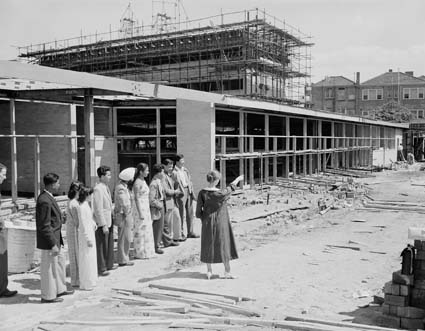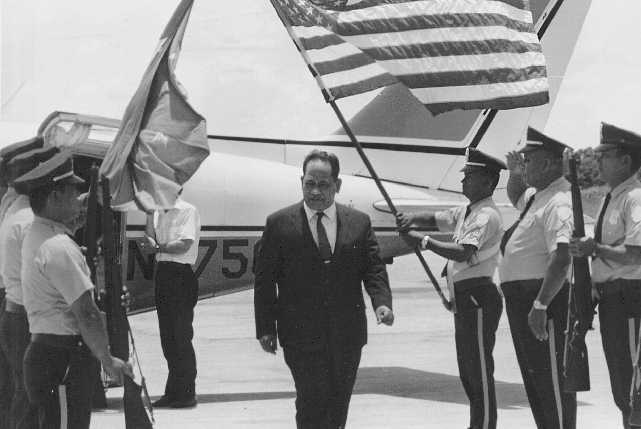“Three Malayan freshers have a friendly chat with two Australian “oldtimers”. From left to right are: Miss Helen Friday, Miss Nafsiah binti Abdul Kadit, of Malaya, Mr Pang Khok Khee, of Malaya, Mr Choo See Mun, of Malaya and Mr Robert Bunton. Photographer, Neil Murray, NAA: A1501, A2254/1
International education is in crisis, both in Australia and around the world. It is time for Australians to learn more about international education and why it is important.
Restrictions on travel have kept students from travelling to Australia for study, and has limited the options of those already in Australia. International students are queueing for food vouchers in the streets of Melbourne and Sydney, universities are losing staff and funds as international student fees dry up. The place of international education in the relationship between Australia and China is now regularly discussed, with racism and geopolitics all part of the conversation. Academics, policy makers and commentators are asking serious questions about what international education will look like on the other side of this crisis.
This is not the best way for many in the Australian community to be learning about international education, and the presence of half a million students in their community, but it is, unfortunately, the circumstance we find ourselves in.
This is not the first time that a crisis has brought international education into popular and political view. The last “perfect storm” of 2008-2010, involved a financial crisis, the closure of a number of private providers and a series of racist attacks. This pushed the sector into view and into the minds of analysts who don’t regularly engage with international education – for example the intervention of the foreign policy think-tank the Lowy Institute, with a briefing paper written by Michael Wesley . The current crisis, which is far more serious than the previous perfect storm, has also brought out the security analysts. A recent opinion piece in the Canberra Times, written by two employees of the Australian Strategic Policy Institute, was a lesson in how not to discuss international education in public forums, and others more closely aligned with recruitment and admissions may wish to respond to the inaccuracies within it.
But the presence of these conversations in public forums and policy think tanks offers those of us in the sector an opportunity to continue that conversation; to further the discussion about international education using our own research and knowledge.
My doctoral research is focused on the history of international education, and the scholarships the Australian government offered to students from the Pacific islands. I’ve been looking closely at the international education policies of governments and the attitudes of the Australian community, from the 1940s to now.
Before a policy change in 1951, non-European international students had limited access to Australian higher education. Scholars from the Pacific Islands instead chose to study in New Zealand and the United Kingdom because it was too difficult to navigate the requirements and restrictions. The changes of 1951, and the beginning of two key scholarship programs, led to Australian higher education opening up to international students. In response to the arrival of students from South and South East Asia the community mobilised to welcome them. Individuals and groups such as the Country Womens’ Association and Rotary joined to form committees to support them. The students were supported with housing, entertainment, holiday arrangements and more.

Miss Ann Beckett (foreground) vice president of the Australia-Overseas Club at Melbourne University, shows a group of Asian “freshers” the frame work of International House, which is to be shared by Asian and Australian students as a residential and cultural centre [photographic image]. Photographer / Neil Murray, source NAA: A1501, A790/9
Importantly, however, the community organisations that supported these students recognised that this was not a one-way street. One group in Sydney, in an effort to recruit more members to their organisation, noted in 1956 that “The presence of these students here is also helping to enrich Australian life.“
Our current moment harks back to these community engagements. Craig Foster is one example of a prominent Australian using his platform to highlight the needs of international students in this current crisis – and direct help to where it is needed. Restaurant owners and other community members are also offering food to international students, and the Australian Homestay Network is coordinating volunteers who have spare rooms to offer. It is these interventions, and lessons from the community engagement of the 20th century, that provide us with instructive examples for how to engage the Australian community in a conversation about international education.
In a previous era of community engagement that was less focused on emergency support, students were able to engage with communities through homestay, farm-stay holidays and guest speaker engagements. These interactions, as Prof. David Lowe and I have discussed elsewhere, helped Australia to become more globally aware in a time when international travel was rare.
Another recent example of how to continue this conversation was a recent episode of the ABC Melbourne Conversation Hour. The ABC Conversations discussion was a about international education – but very specifically not about the financial side. It talked about the humans that come to Australia for multitudes of reasons and have excellent and terrible experiences – but usually go home, or stay, as more developed humans. The hosts were honest about how much they didn’t know about international education in Australia. They were excited and keen to learn more, and the discussion was nuanced.
To discuss international students as humans, and to think about the role they play in our community – as students, parents, workers, partners, volunteers and more – is unfortunately an exception.

Founding president of Nauru and alumnus of Gordon Institute of Technology in Geelong, Hammer DeRoburt in Saipan, 1977. Source: Wikimedia Commons
There are plenty of examples of the way in which international students have been changed by their time in Australia – Presidents, Vice-Presidents, senior academics, writers, teachers and community leaders have taken the skills they learnt in Australia and applied them in their own countries. But we talk less about their impact on Australia: how the presence of Australia has changed towns, cities and communities in Australia.; and how the contribution of international students has allowed the Australian community to learn about the world from the “comfort” of our own classrooms, lecture theatres and Korean Fried Chicken shops.
But if Australia is to welcome international students back at any scale it is a conversation that must become the norm. If international students are to survive in Australia during this pandemic, and their peers offshore are to return to Australia, these students need to feel that they will be safe, both from the pandemic and within the community. The Australian community needs to feel that these students should be supported in the community. That conversations starts with understanding why international students should be a part of the Australian community, and what we can do to make them a welcome part of that community.

